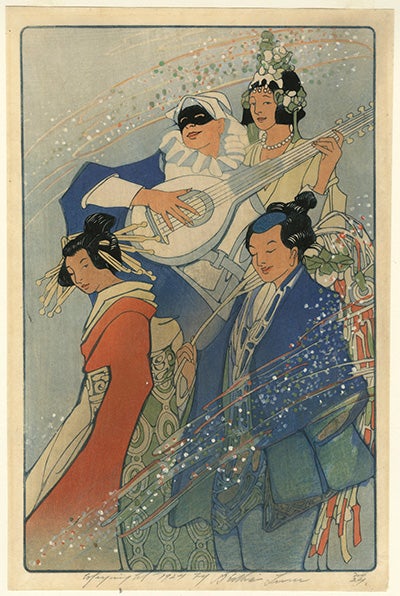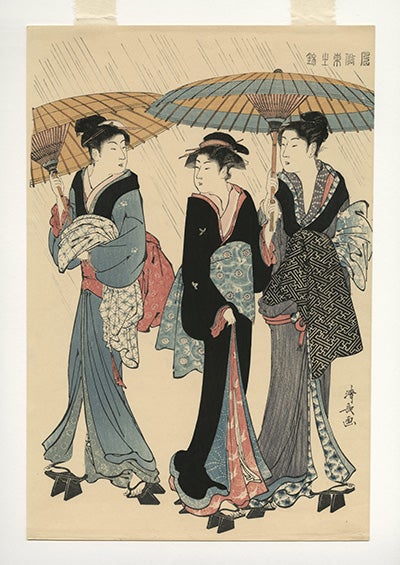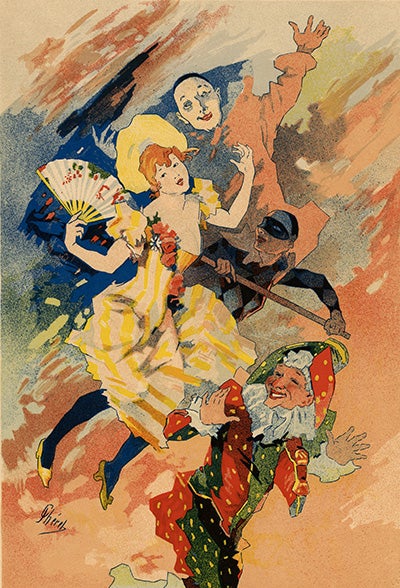The ability to print and reproduce artwork was the art world's pre-internet. Printing and sharing images allowed artists to study new styles, merge methods of art production and represent old subjects in new media, revolutionizing the art world. Without the capability of reproducing prints, Iowa born artist Bertha Boynton Lum would have never combined the French subjects of Commedia dell'arte in the style of Japanese woodblock prints.

Costume Ball (1924)
Woodcut on paper by Bertha Boynton Lum
Georgetown University Art Collection 1111.1.653
Born in 1869, Bertha Lum started her career in the design department at the Art Institute of Chicago at the peak of the fin de siècle style. She returned to the Art Institute in the early 19th century to work with Arthur Wesley Dow, who introduced her to Japanese Woodblock printing. While printing was not popularized in Europe until the 15th century, printing was used in Asia as early as the third century. Lum spent a seven-week honeymoon in Japan and sought a printmaker who could teach her the traditional ukiyo-e method (pictures of the floating world).

Untitled [3 Women in the rain, two with umbrellas] (ca. 1783)
Woodcut on Paper by Torii Kiyonaga
Georgetown University Art Collection 1111.1.5061
Lum’s work is most akin to the bijin-ga (beautiful person picture) genre. One of the great masters of this genre is Torii Kiyonaga, born Sekiguchi Shinsuke (1752-1815), who passed away around 75 years before Lum’s first visit to Japan. He started out making promotional materials depicting Kabuki actors for theaters. Untitled [3 women in the rain, two with umbrellas] is a prime example of the bijin-ga style.
Toward the end of Lum’s trip to Japan, she discovered a shop that reproduced old prints like that of Kiyonaga’s work. She returned to Minneapolis with the woodcutting tools they sold her and began her practice. Four years later, she returned to Japan for a longer stay, and a professor of the Imperial Art School in Tokyo introduced her to engravers and printers with whom to train. She returned to the United States and printed there until she moved to Peking, China during the 1920s. She stayed in China until 1953 when she moved to Genoa, Italy and died there a year later.
While her work is in the bijin-ga style, Costume Ball (1924) alludes to French lithographs that depict Commedia dell’arte (comedy of the profession), such as the work of Jules Chéret (1836-1932) master of the Belle Époque (Beautiful Era).

(Commedia dell'Arte Figures) for Maîtres de l'Affiche (plate 201) (1898)
Lithograph by Jules Chéret
Georgetown University Art Collection 1996.38.6
In this work, (Commedia dell'Arte Figures) for Maîtres de l'Affiche, we see several figures from the Commedia dell’arte. Commedia dell’arte was a theater production originating in Italy known for its masked typed characters. Perhaps the most famous masked type is that of the Harlequin. In Chéret’s figure his Cherette, possibly a Colombina figure (a perky maid), accompanies two Harlequin figures (servant figure known for colorful clothing) and one Pierrot (sad clown wearing a white flowy costume with large buttons). Lum also depicts a Pierrot figure wearing a black mask and a white frock with a ruff. Coincidentally, Lum’s Pierrot figure playing an instrument is highly reminiscent of André Derain’s painting created in the same year, Harlequin and Pierrot (1924), that is housed at the musée de l'Orangerie, thus underlining the French connection.
Lum’s work speaks to the fluid nature of prints. The print’s ability to travel across the globe allowed for Lum, an American woman, to combine French subjects of Italian theatre in a Japanese style.
--Katie O’Hara, University Art Collection Curatorial Intern and Graduate Student in Art and Museum Studies
November 12, 2018
